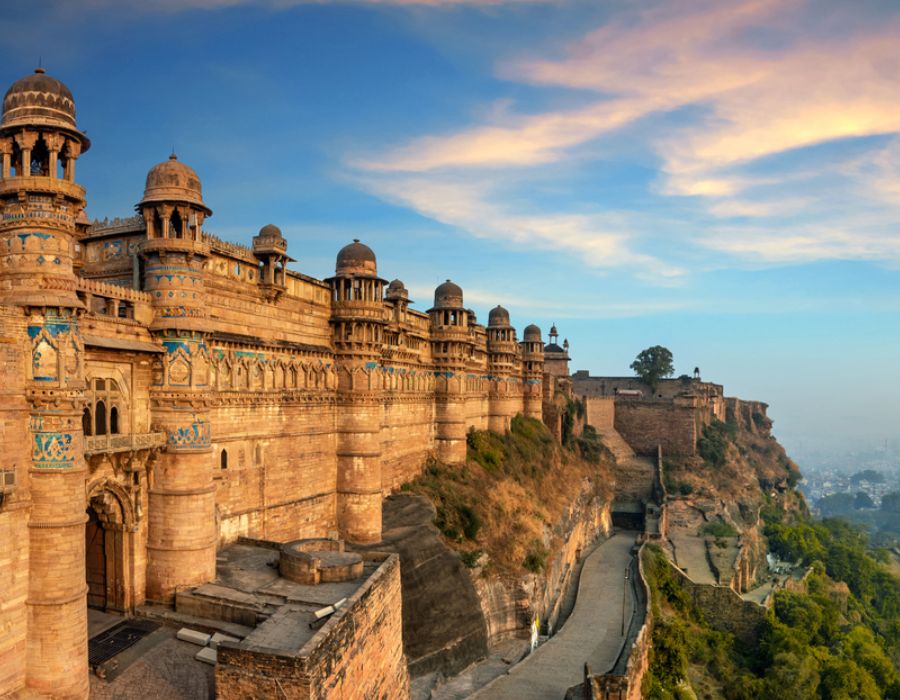3 Days 2 Nights
Daily Tour
Unlimited
English
If you are looking for a perfect blend of history, culture, and natural beauty, Gwalior is the place to be. Located in the heart of Madhya Pradesh, Gwalior is a city that boasts of a rich cultural and historical heritage. With its magnificent palaces, ancient temples, and grand fortresses, Gwalior tour is a perfect destination for those who love to explore the past and delve into the grandeur of the bygone era.
Gwalior, also known as the land of the great warriors, is one of the most fascinating tourist destinations in India. The city is a treasure trove of history, culture, and art that dates back to several centuries. The majestic Gwalior Fort, which stands on a hilltop, is the centerpiece of the city and is an architectural marvel that has witnessed the rise and fall of several dynasties.
Gwalior is also known for its rich musical heritage, which is evident in its numerous temples, museums, and music festivals. The city is home to some of the most renowned musicians, including the legendary Tansen, who was one of the nine jewels in the court of Emperor Akbar.
The Gwalior Fort is undoubtedly the most iconic landmark of the city and a must-visit attraction for any tourist. The fort complex covers an area of around 3 square kilometers and is home to several magnificent palaces, temples, and monuments. The fort dates back to the 8th century and has been ruled by several dynasties, including the Tomars, Mughals, and Scindias.
The fort is famous for its stunning architecture, which is a blend of Hindu, Mughal, and European styles. Some of the must-visit attractions inside the fort complex include the Man Mandir Palace, Teli ka Mandir, Saas-Bahu Temple, and the Jauhar Pond.
The Jai Vilas Palace is another stunning attraction that is a must-visit for any tourist visiting Gwalior. The palace was built by Maharaja Jayajirao Scindia in the 19th century and is an excellent example of European architecture blended with Indian craftsmanship. The palace covers an area of around 25 acres and boasts of several grand halls, gardens, and courtyards.
One of the main highlights of the palace is the Durbar Hall, which is adorned with gold and silver furniture, crystal chandeliers, and a magnificent carpet that weighs several tons. The palace also houses a museum that showcases the life and times of the Scindia dynasty.
Tansen was one of the most renowned musicians in the court of Emperor Akbar and is considered the father of Hindustani classical music. His tomb is located in Gwalior and is a must-visit attraction for anyone interested in music and history. The tomb is a beautiful example of Mughal architecture and is surrounded by a serene garden.
The Sun Temple is another famous attraction in Gwalior that is dedicated to the Hindu deity, Sun. The temple was built in the 11th century and is famous for its exquisite carvings and architecture. The temple is located on a hilltop and offers panoramic views of the city.



Your captivating Gwalior Exploration Tour concludes here. We hope you had a wonderful experience delving into the cultural and historical treasures of this remarkable city.
Two to three days are sufficient to explore the major attractions of Gwalior. This will give you enough time to visit the Gwalior Fort, Jai Vilas Palace, Teli Ka Mandir, and other important landmarks. You can also indulge in local cuisine and shopping during your visit.
One of the most famous sweets in Gwalior is the Mawa-Bati, also known as Gulab Jamun. It is a round-shaped dessert made from khoya (mawa) and soaked in sugar syrup. The dish is often served during festivals and special occasions, and can be found in many sweet shops and restaurants throughout the city.
The best time to visit Gwalior is during the winter months from October to March. The weather during this time is pleasant with temperatures ranging from 10 to 27 degrees Celsius.
Gwalior is well connected to major cities in India by air, rail, and road. By Air: The nearest airport to Gwalior is Rajmata Vijaya Raje Scindia Airport, which is located about 12 km from the city center. It is well connected to major cities in India such as Delhi, Mumbai, and Kolkata. By Rail: Gwalior Railway Station is a major railway station and is well connected to major cities in India such as Delhi, Mumbai, Kolkata, and Chennai. Several trains, including Rajdhani and Shatabdi Express, also run between Gwalior and Delhi. By Road: Gwalior is well connected to major cities in Madhya Pradesh and nearby states such as Uttar Pradesh and Rajasthan by road. National highways NH 3, NH 75, and NH 27 pass through Gwalior, making it easily accessible by road.
Leave a review